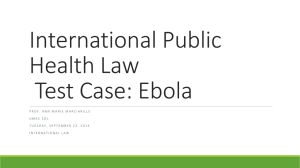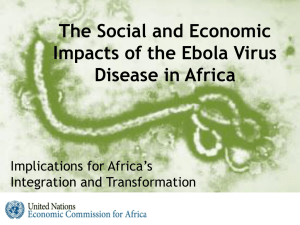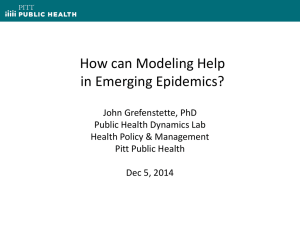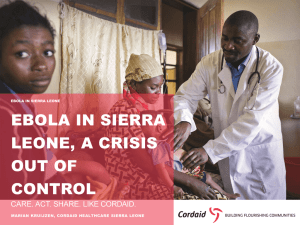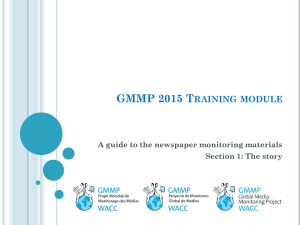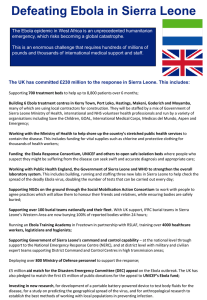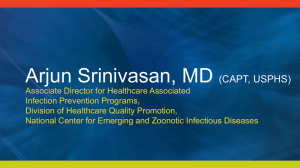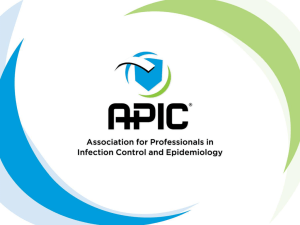Personal Protective Equipment
advertisement
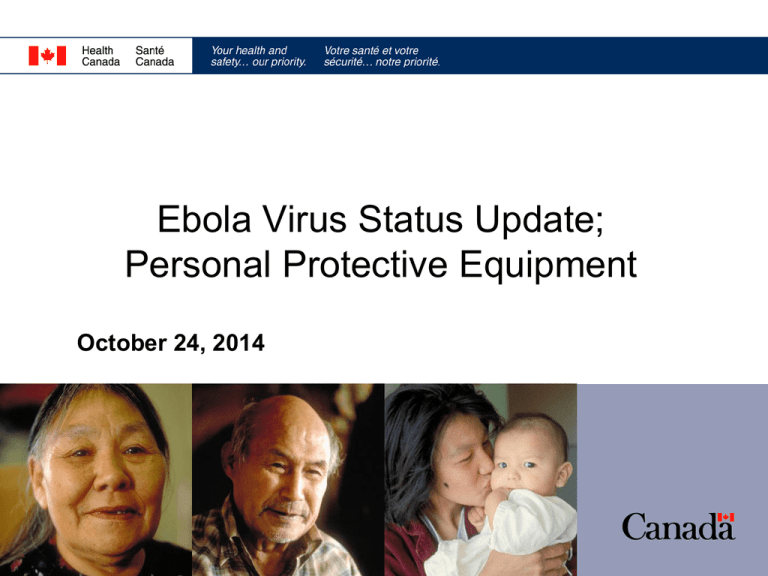
Ebola Virus Status Update; Personal Protective Equipment October 24, 2014 Outline • Overview of Ebola situation • Point of Care Risk Assessment process • Personal Protective Equipment 2 Ebola Update • Ebola outbreak is of primary concern in Sierra Leone, Liberia, and Guinea. • Risk to Canadians is very low • Transmission to humans: • Contact with infected wild animals in West Africa (fruit bats, non-human primates, rodents) • Direct contact with infected humans – Blood, other body fluids, tissues from infected individuals – Environmental contamination • Incubation is 2 to 21 days • Communicable from symptom onset to symptom resolution 3 Ebola Update Roles of various Agencies: • • • WHO is coordinating response in Africa PHAC is coordinating response in Canada Alberta Health and Alberta Health Services are coordinating response in Alberta – FNIHB AB Region is included in update meetings 4 Ebola Update PHAC Response • Screening at ports of entry into Canada • Quarantine for 21 days if required • Assisting in international response • Expert response teams on standby to support case management anywhere in Canada if requested by jurisdiction • Development of Guidance Documents • FNIHB working in coordination with PHAC nationally 5 Ebola Update Response in Alberta • Screening occurring at airports • • • AHS developing guidance documents - with related training - for designated hospitals, front line workers (doctors, first responders, community based staff) • • • Phased approach based on risk assessment Purchasing appropriate PPE Plan for regular communications: • • • Designated hospitals in Edmonton (2) and Calgary (2) Process for notification to Public Health Health care providers Public FNIHB AB Region working in coordination with AH/AHS. 6 Ebola Update Community Response • Preference is for people to contact Health Link where triage will occur vs coming into health centre. If people present: • Guidance for triage in patients with fever: • Is temperature at least 380C? • Any travel or residence in Guinea, Sierra Leone, or Liberia within past 21 days? 7 Ebola Update • Where there is relevant travel and symptom history: • Does the person need immediate emergency treatment? – Call 911, ensuring to notify dispatcher of potential risk • If does not need immediate treatment: – Separate room, implement droplet and contact precautions – Call on-call number: 780-218-9929 • If there is no relevant travel and symptom history, not considered an Ebola risk. 8 Ebola Update – Canadian Context • Remember: fevers are associated with many disease processes, including malaria, influenza, dehydration (for any cause). • The risk for Ebola to be present without history of travel to affected countries is extremely low. 9 Ebola Update Key information websites: World Health Organization: http://www.who.int/csr/disease/ebola/en/ Public Health Agency of Canada: http://www.phacaspc.gc.ca/id-mi/vhf-fvh/ebola-eng.php Alberta Health: http://www.health.alberta.ca/healthinfo/ebola-virus.html Alberta Health Services: http://www.albertahealthservices.ca/10289.asp 10 POINT OF CARE RISK ASSESSMENT 11 Point of Care Risk Assessment Algorithm and related resources were rolled out spring 2014. PCRA Algorithm Additional Precautions Overview See: OneHealth, CDC Manual, under “CDC Manual Forms” 12 PERSONAL PROTECTIVE EQUIPMENT 13 Personal Protective Equipment Routine PPE: • Gowns • Current stock is not impermeable • Gloves • Masks • Procedure mask • N95 masks • Face shields • Don’t forget hand hygiene! 14 Personal Protective Equipment • N95 masks: • Only required where respiratory precautions are indicated (TB, measles, aerosol-generating medical procedures) • Fit tests have been done in the past, during on-boarding – FNIHB AB region does not currently have process to update fit testing – Remember to do seal test with N95 masks 15 Personal Protective Equipment • Ensure that there is supply of routine PPE. • Ensure that there is a supply of procedure masks available: • For use with clients presenting in the health centre or clinic with new cough • Ensure that there is access to hand hygiene: • soap and water is adequate for public • Waterless hand gels is preferred product for HCWs 16 Personal Protective Equipment • It is important to understand principles behind PPE to ensure best protection: area to be protected should be completely covered Prevent contamination during doffing 17 Personal Protective Equipment • Alberta Health Services Video – demonstrating proper technique for donning and doffing PPE • http://www.albertahealthservices.ca/6422.asp • All staff should: • review the PCRA tool as it is applicable to your practice and various settings • practice donning and doffing full PPE with a partner 18 Environmental Cleaning • During respiratory season, ensure that high touch surfaces are regularly cleaned. • ViroxTM products do inactivate viruses. 19 Thank you! Contacts: Ruth Richardson 780-495-5439 ruth.richardson@hc-sc.gc.ca Dr. Parminder Thiara 403-861-8447 parminder.thiara@hc-sc.gc.ca Dr. Wadieh Yacoub 780-495-3391 wadieh.yacoub@hc-sc.gc.ca 20


